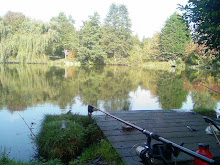
Carp is the common name for various freshwater fishes of the family "Cyprinidae".
Carp have long been an important food fish to humans as well as very popular ornamental fish. As a result, carp have been introduced to various locations where they are often considered pests because they thrive in very large numbers, with each female being able to lay up to 80,000 eggs.
Carp originate from Asia, and were introduced to England from western Europe during the 13th century, when they were cultivated mainly by the monks as a food fish.
Introduced carp readily adapted to their new environment, spreading rapidly throughout any drainage area in which they were released. Carp have since become naturalized in almost every water in which they were introduced.
While tasty when grown in good water, carp tend to have small bones and fish that live in muddy waters can acquire a muddy flavour. The value of carp as food varies, In China, Japan, and Taiwan carp are esteemed as food fish and are also considered to be signs of good fortune, so are often served at banquets and other formal meals.In Central and Eastern Europe, carp are also much appreciated, and are traditionally eaten on Christmas Eve in the Czech Republic, Slovakia, Germany, Croatia, Hungary and Poland.
In the UK, on the other hand, carp are rarely eaten. The common carp is one of the most aqua cultured consumption fish in the world, produced in the hundreds of thousands of tons annually.
Carp are similarly variable in terms of angling value. In Europe even when not fished for as food they are eagerly sought out by anglers, being considered wily fish that are difficult to hook.
Carp, along with many of their cyprinid relatives, are popular ornamental aquarium and pond fish. The two most notable ornamental carps are goldfish and koi.
The koi, an ornamental variety of carp (Cyprinus carpio). The koi are historically a prevalent symbol in Japanese culture of good luck. They are shown in fish shows all over the world.
Goldfish and koi have advantages over most ornamental fishes, as they are tolerant of cold (they can survive in temperatures as low as 4 degrees celsius), and can survive low oxygen levels.
In some countries, due to their habit of grubbing through bottom sediments for food and alteration of their environment, they destroy, uproot and disturb submerged vegetation causing serious damage to native duck and fish populations.
In Australia there is enormous anecdotal and mounting scientific evidence that introduced carp are the cause of permanent turbidity and loss of submergent vegetation in the Murray-Darling river system, with severe consequences for river ecosystems, water quality and native fish species.
Carp have attributes that allow them to be an invasive species - a species that invades and dominates new ecosystems with serious negative effects to the ecosystem and native fauna, earning the reputation as "rough fish".
In Chinese Mythology, there is said to be a place called Dragon's Gate. Dragon's Gate resides at the top of a waterfall. It is said if a carp can jump over the waterfall from the waters below, it will become a beautiful dragon.

No comments:
Post a Comment
Please keep your comments clean and informative - Thanks, Gary.